The Inner Planets’ Dance Climaxes with a Kiss and the Super Milk Moon Gets Eclipsed!

Michael Watson of Toronto captured this trio of images of the April 15, 2014 lunar eclipse. He carefully positioned the moon to show its east to west motion and the circular shape of Earth’s shadow. For the total lunar eclipse of Wednesday, May 26, 2021 the moon will instead cross through the upper half of the Earth’s shadow. Michael’s galleries of images are here.
Hello, May Moon Lovers!
Here are your Astronomy Skylights for the week of May 23rd, 2021 by Chris Vaughan. Feel free to pass this along to your friends and send me your comments, questions, and suggested topics. You can also follow me on Twitter as @astrogeoguy! Unless otherwise noted, all times are expressed in Eastern Time. To subscribe to these emails please click this MailChimp link.
I can bring my Digital Starlab portable inflatable planetarium to your school or other daytime or evening event, or teach a session online. Contact me through AstroGeo.ca, and we’ll tour the Universe, or the Earth’s interior, together!
Unfortunately for stargazers around the world, this week will be dominated by the bright moon – both in the sky and on the news. Wednesday morning will bring us a full supermoon total lunar eclipse! So let’s make “lumenade” and discuss some lunar science. Mercury’s dance with brighter Venus will climax on Friday when they kiss. And the bright gas giant planets can be viewed in the hours before dawn. Read on for your Skylights!
Moon Phases Decoded
For most of this week, the moon will dominate evening skies all around the world – and much of the world will be treated to a supermoon total lunar eclipse! Our natural satellite offers plenty of interesting viewing using your unaided eyes, binoculars, and telescopes of any size. So let’s focus on the moon – summarizing its change in appearance, its dip into Earth’s shadow, and some sights to see on it!
Today (Sunday) the moon will exhibit an appearance that astronomers call waxing gibbous. The moon spends half of its 29.5 day cycle waxing in phase and the other half waning in phase. The term phase describes the amount of the moon’s disk that is illuminated, as viewed from Earth. Our vantage point is an important aspect to the phenomenon – the moon’s sphere is always half-illuminated by the sun. (Unless Earth is in the way – as is the case during a lunar eclipse.) That lit-up hemisphere faces toward Earth at every full moon phase, faces away from Earth at every new moon phase, and is sideways to Earth at the first and third quarter phases. Everyone on Earth sees the same lunar phase once the moon rises in their local sky.
The term waxing means increasing – in this case, in the percent of the moon we see as illuminated. The moon waxes in phase while the moon is increasing its angle from the sun. The increase in Illumination is obvious from one night to the next, but it is also happening minute by minute and hour by hour. (You can view the moon in a telescope early in the evening and then look again an hour or two later and see the difference.) The moon waxes between new moon (not illuminated at all from Earth) and full moon (completely illuminated from Earth). It wanes back to new moon because the moon’s angular separation from the sun is decreasing during those two weeks. Evening moons are always waxing, while pre-dawn moons are always waning.
When the moon looks more than half-illuminated, it’s called a gibbous moon. When it looks less than half-illuminated, it is a crescent moon. From new moon to first quarter, we see a waxing crescent moon. From first quarter to full moon, we see a waxing gibbous moon. From full moon to third quarter, we see a waning gibbous moon. And from third quarter to new moon, we see a waning crescent moon.
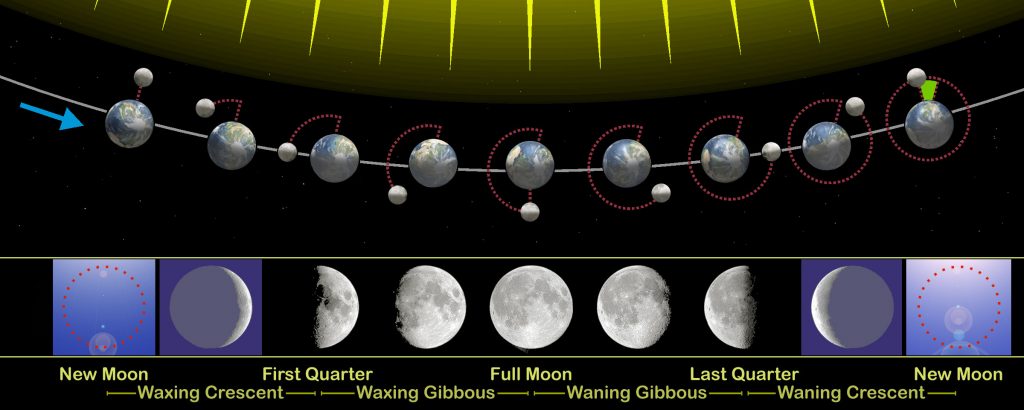
The boundary dividing the moon’s lit and dark hemispheres follows a ring that girdles the moon and passes through, or close to, the moon’s north and south poles. It’s called the terminator. All solid objects in space have terminators. You can see the terminators of Mercury and Venus in a telescope. Most of the time we see the moon’s terminator as curved. At first and third quarter phase it becomes a straight line. You can re-create the phenomenon by drawing a line around a tennis ball. Hold the ball so that the line passes through your finger and thumb, rotate the ball and watch the shape of the line vary. It’s how even ancient astronomers knew that the moon was a sphere.
By noting the tilt of the lunar terminator, you can observe how the moon’s orientation varies as it crosses the sky due to Earth’s diurnal rotation. When the moon rises in the east, its north pole is towards your left and the terminator is more left-right than up-down (if you are viewing it from the Northern Hemisphere). When it is over the southern horizon, the pole is at the top and the terminator is up-down. And when the moon sets, its north pole will be tipped towards your right, and the terminator will be left-right again. To be clear, the moon is not tilting – we are! The tilted terminator effect gives us the “horns of the moon” and the “Cheshire Cat’s Smile” effect at sunset.
Getting back to today (Sunday), the moon will rise in late-afternoon, shine prominently during this evening, and set in the wee hours after midnight. That timing is what makes viewing the moon so convenient when it is between first quarter and full. As the moon’s angle from the sun increases every day, it also rises later and sets later. When we reach Wednesday’s full moon, the moon will rise at sunset and set at sunrise – but the late sunsets in May and June cause full moons to rise well after bedtime for youngsters.
Tonight (Sunday) the moon will shine among the modest stars of the Maiden, Virgo. On Monday and Tuesday, the very bright moon will traverse the dim stars of Libra (the Scales). For the rest of this week, the moon will journey through the late-rising summertime constellations of Ophiuchus (the Serpent-Bearer), Sagittarius (the Archer), and Capricornus (the Sea-Goat). You’ll find it shining over the southern horizon at sunrise.
A Full Flower Blood Supermoon!
The moon will officially reach its full phase at 7:14 am EDT (or 11:14 Greenwich Mean Time) on Wednesday, May 26 – while it’s below the southwestern horizon in the Eastern Time Zone. As a matter of fact, the full moon will be setting as the sun rises for observers in Central Canada and the USA. Only in Central Asia and Australia will this moon be exactly full when it rises.
With the moon’s full phase arriving in early morning on Wednesday in the Eastern Time Zone, observers living in that region will see the moon as very slightly less than full on Tuesday night. Binoculars will reveal a thin strip of darkened moon along the moon’s western limb. (That’s the moon’s left side for Northern Hemisphere observers – and the moon’s right side if you live down under.) At a casual glance, the moon will also look completely full on Wednesday evening, but it will already be missing a sliver of illumination along its eastern (right-hand) limb.
Every culture around the world has developed its own stories about the full moon, and has assigned special names to each one. The indigenous Ojibwe groups of the Great Lakes region call the May full moon Zaagibagaa-giizis “Budding Moon” or Namebine-giizis, the “Sucker Moon”. For them it signifies a time when Mother Earth again provides healing medicines. The Cree of North America call it Athikipisim, the “the Frog Moon” – the time when frogs become active in ponds and swamps. In the Mi’kmaq lunar calendar, this is Etquljewiku, the Frog-Croaking Moon. The Cherokee call it Ahnisguti, the “the Planting Moon”, when the fields are plowed and sown.
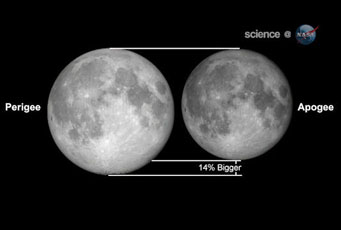
In European cultures, this moon is commonly nick-named the Full Milk Moon, Full Flower Moon, or Full Corn Planting Moon. This full moon will occur 9 hours after perigee, the point in the moon’s orbit when it is closest to Earth, making this the largest supermoon in 2021. Supermoons occur in consecutive groups or three or four – about every 14 months. During those periods, the moon’s 27.32-day sidereal orbital period that causes perigees and apogees temporarily aligns with the 29.53-day synodic period that produces the moon’s phases. An astrologer named Richard Nolle appears to have coined the term in 1979, and has refined it since then. His “definition” requires that the moon be full while it is also within 90% of its closest approach to Earth – or within about 360,000 km. Supermoons look about 16% brighter and 7% larger than average.
Don’t forget that any moon, even a supermoon, can easily be covered by a pinky fingernail held at arm’s length and one eye closed. That even applies to little children’s tiny fingers! By the way, the astronomical term for an alignment of three celestial objects is a syzygy – in this case, the sun, Earth, and moon. So this full supermoon will be a lunar perigee syzygy. But wait, there’s more!
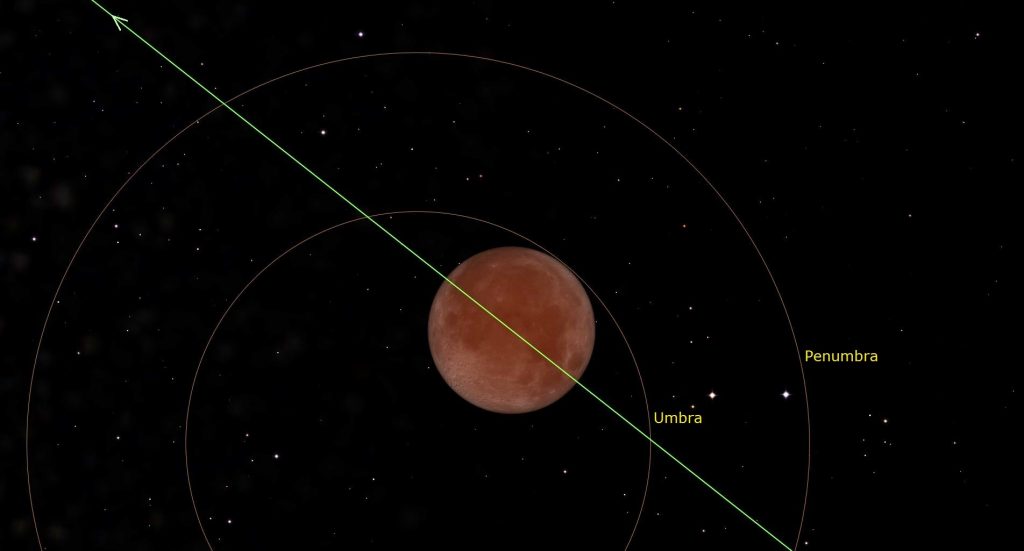
This full moon will also generate a total lunar eclipse because the full moon will occur while it is close to the ecliptic – allowing it to pass through Earth’s circular shadow! Due to the enlarged supermoon effect, this eclipse will barely qualify as a total one. When at maximum eclipse, the northern limb of the moon will be a scant 0.3 arc-minutes (or 1% of the moon’s diameter) inside the northern edge of the Earth’s shadow or umbra – limiting the length of totality to just 14.5 minutes. Observers should expect the southern half of the moon, which will extend much deeper into the umbra, to look noticeably darker than the northern half. The word “blood” has been coined by the media because a fully eclipsed moon turns reddish. It is only receiving sunlight that has passed horizontally through Earth’s atmosphere. An astronaut standing on the moon during a total lunar eclipse would see a reddish ring of sunset-coloured light all around the Earth’s edge!
The moon will start dipping into Earth penumbra at 8:49 GMT (or 4:49 am Eastern Daylight Time) – but it won’t darken very much until it makes first contact with Earth’s umbra at 9:44:57 GMT (or 4:45 am CDT). The moon will pass out of the far edge of the umbra three hours later at 12:52:22 GMT (or 7:52 a.m. CDT). The entire eclipse will be visible across the Pacific Ocean, and from New Zealand and eastern Australia. Except for the northeastern states and provinces, observers in the Americas will see at least the initial stages of this eclipse – but the moon will set before the eclipse ends for observers on the west coasts.

Unfortunately, in the Great Lakes region, the moon will set just as it is starting to enter the umbra – at about 5:45 am EDT. Winnipeg will see the moon about 70% eclipsed when it sets. Calgary and points west will see totality. Lunar eclipses are completely safe to observe unfiltered with your unaided eyes, binoculars, and telescopes.
What to See on the Moon
Looking at the moon through binoculars and telescopes this week will show you the tremendous difference in the way sunlight illuminates the moon, and the impact that has. On Sunday and Monday, view the moon along the terminator. With no atmosphere to scatter light, the shadows cast by every crater rim, mountain, and ridge are a deep black – and even very small bumps and ridges are highlighted, revealing otherwise hidden features on crater floors.
On Tuesday and Wednesday night the moon will be fully illuminated, and the light striking the moon then will be coming from directly “behind you” when you face the full moon – the same way the projector in a cinema lights up the movie screen in front of you. That sunlight is arriving straight-on to the moon’s surface, so it doesn’t generate any shadows. Every variation in brightness and colour you see on a full moon is due entirely to the moon’s geology, not its topography! Now you can easily distinguish the dark, grey basalt rocks from the bright, white aluminum-rich anorthosite rocks.
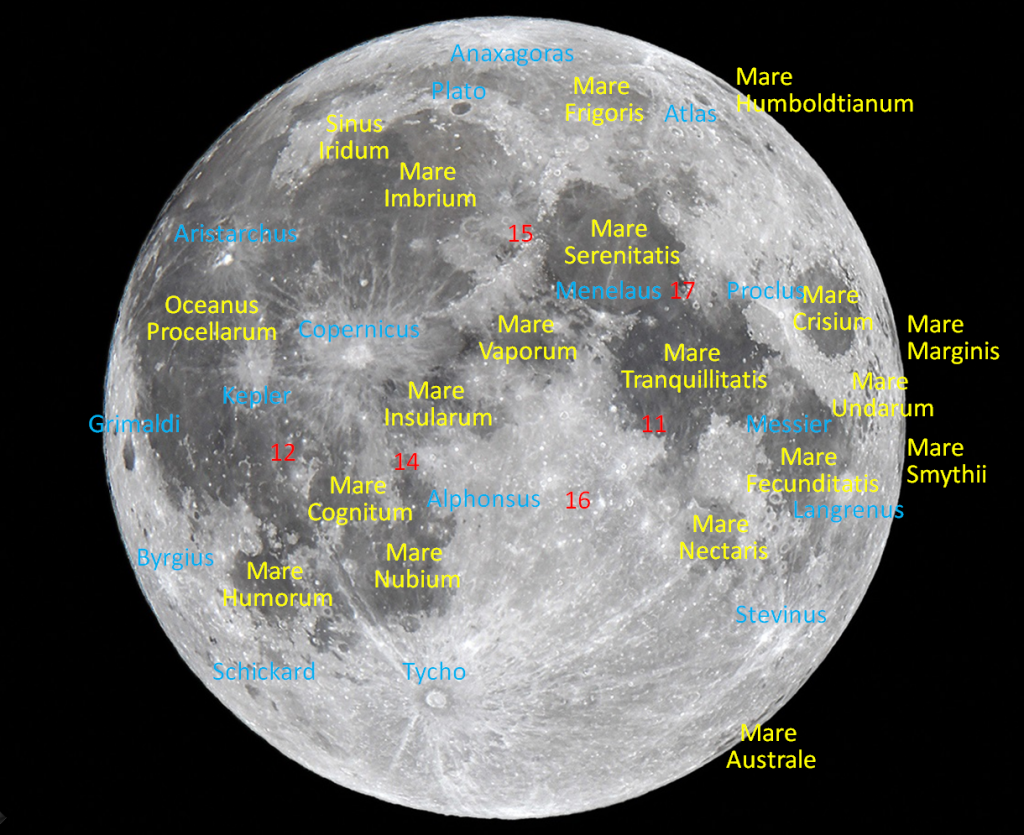
The basalts overlay the various lunar maria, Latin for “moon seas” – coined because people used to think they were water-filled. The maria are basins excavated by major impactors early in the moon’s geologic history and later infilled with dark basaltic rock that upwelled from the interior of the moon late in the moon’s geological history.
The much older and brighter parts of the moon are composed of anorthosite rock. Those areas are higher in elevation and are heavily cratered – because there is no wind and water, or plate tectonics, to erase the scars of impacts. By the way, the bright, white appearance is produced by sunlight reflecting off of the crystals the rock is made of – the same sort of crystals you see in the granite countertops in Earth’s kitchens. And yes, there are coloured rocks on the moon.
Some of the violent impacts that created the craters in the highland regions also threw bright streams of ejected material far outward and onto the darker maria. We call those streaks lunar rays. Some rays are thousands of km in length – like the ones emanating from the very bright crater Tycho in the moon’s southern central region.
Use your binoculars to scan around the full moon. There are smaller ray systems everywhere! There are also places where craters punched into the maria have ejected dark rays on to white rocks. And, since the dark basalt overlays the white, older rock below, you can find lots of craters where a hole has been punched through the dark rock, producing a white-bottomed crater!
Several of the maria link together to form a curving chain across the northern half of the moon’s near-side. Mare Tranquillitatis, where humanity first walked upon the moon, is the large, round mare in the centre of the chain. You can plainly see that this mare is darker and bluer than the others, due to its basalt being enriched by the mineral titanium. That’s one of the reasons why Apollo 11 was sent to that location.
By the way, even the largest Earth-bound telescopes cannot see the items left by the astronauts on the moon. When the air is particularly steady, the smallest feature you can see on the moon with your backyard telescope is about 2 to 6 km across – far larger than a lunar module descent stage. Only the cameras on spacecraft in orbit around the moon can photograph the astronauts’ footprints, lunar rover tracks, and equipment.
The Planets
The dance of the inner planets Mercury and Venus will reach a dramatic climax this week! Both of them can be seen shining low in the west-northwestern sky after sunset. Very bright Venus is slowly drawing away from the sun. It climbs a little higher each night, and will be setting at about 10 pm local time. Mercury reached its widest angle from the sun last Sunday – so it is now rapidly descending sunward again.

On the evenings surrounding Friday, May 28, speedy Mercury will pass extremely close to much brighter Venus. At their closest approach on Friday, the two planets will be separated by only 25 arc-minutes – close enough to appear together in the eyepiece of a backyard telescope. (Don’t point optical aids in that area of sky until after the sun has completely set.) Find a spot with a low, unobstructed horizon and start looking for magnitude -3.85 Venus above the west-northwestern horizon after about 9 pm local time. Once the sky darkens sufficiently, magnitude 2.26 Mercury, 280 times dimmer than Venus, will appear to Venus’ left (or celestial south). Should Friday be cloudy, you can view Mercury when it’s a little above Venus on Thursday, or little bit below Venus on Saturday.
Venus, on far side of the sun from Earth, will show a round, nearly fully illuminated disk in a telescope. Mercury, which is between us and the sun, will show a thin crescent – on the sunward side, of course! Telescope views when the planets are so low in the sky will not be ideal, but their shapes should be apparent!
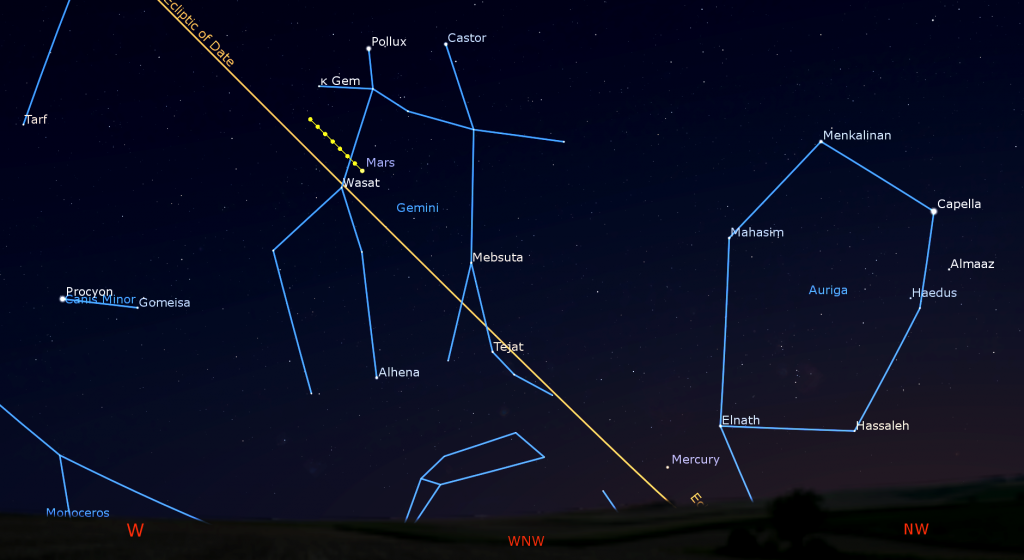
Once the sky has darkened, just before 10 pm local time, look less a third of the way up the west-northwestern sky for the reddish dot of Mars. To help you find it – watch for the very bright white star Procyon shining less than two fist diameters to Mars’ lower left, or the almost-as-bright stars Castor and Pollux, the twins of Gemini, shining a palm’s width above Mars. Despite Mars being much farther from Earth now, your telescope will still show that it has a small, ruddy disk. Start looking at Mars as soon as it pops into view. It will be getting too low to see clearly in a telescope by late evening, and it will set in the west close at about midnight local time.
Saturn and Jupiter are continuing to shine in the southeastern pre-dawn sky. Those two planets will start to become visible in late evening towards the end of June! This week yellow-tinted Saturn will rise within the stars of central Capricornus (the Sea-Goat) after about 1 am local time, and should be easily visible until almost 5 am.
Today (Sunday, May 23) Saturn will cease its regular eastward motion through the distant stars of Capricornus and begin a retrograde loop that will last until mid-October. The apparent reversal in Saturn’s motion is an effect of parallax produced when Earth, on a faster orbit, passes the Ringed Planet on the “inside track”. You can observe the planet’s direction change by noting how Saturn’s distance from the bright star to its left (east) named Theta Capricornus varies over several days.

Even a small telescope will show Saturn’s rings and several of its brighter moons – especially its largest moon, Titan! Because Saturn’s axis of rotation is tipped about 27° from vertical (a bit more than Earth’s axis), we can see the top surface of its rings, and its moons can arrange themselves above, below, or to either side of the planet. During this week, Titan will migrate counter-clockwise around Saturn, moving from the lower right (celestial southwest) of Saturn on Monday morning to the upper right (northwest) of the planet next Sunday. (Remember that your telescope will flip the view around.) As Saturn moves higher in the sky, it will present a more pleasing view as summer arrives.
Much brighter and whiter Jupiter is positioned among the stars of western Aquarius (the Water-Bearer) about 1.8 fist diameters to Saturn’s lower left (or 18° to the celestial east). Now that Saturn will be moving retrograde, the separation between the two planets will increase every morning. This week Jupiter will rise at about 2 am local time and will be easy to see until almost sunrise.

Due to the very low the morning ecliptic, Jupiter doesn’t get very high above the horizon before the dawn sky hides it, especially for viewers in mid-Northern latitudes. That makes it hard to obtain sharp views of the planet in a telescope. Since the ecliptic is higher for observers at southerly latitudes, both planets will be higher and clearer in telescopes there. If you are willing to get up early and take your backyard telescope outside, the Great Red Spot (or GRS) will be visible crossing Jupiter on Monday, Thursday, and Saturday morning.
Public Astro-Themed Events
Every Monday evening, York University’s Allan I. Carswell Observatory runs an online star party – broadcasting views from four telescopes/cameras, answering viewer questions, and taking requests! Details are here. Their in-person Wednesday night viewing has been converted to online via the observatory YouTube channel, where they offer free online viewing through their rooftop telescopes, including their 1-metre telescope! Details are here.
My free, family-friendly Insider’s Guide to the Galaxy webcasts with Jenna Hinds of RASC National will return on Tuesday afternoon, May 25 at 3:30 pm EDT. We’re going to talk about safely viewing the sun and the upcoming annular solar eclipse. You can find more details, and the schedule of future sessions, here and here.
On Tuesday, May 25 from 10 am to 1 pm EDT, The Origins Institute and Consulat Général de France à Toronto, in partnership with the McMaster Alumni Association will stream a free public symposium about Astrophysics and Astrobiology featuring: Françoise Combes; Christine Wilson; Anne-Marie Lagrange; Laura Parker; Miho Janvier; Allyson Brady; Sian Ford; Alix Dujardin; Rishita Gudapati; Aileen Shanzeela. Details and the Zoom registration link are here.
The Origins Institute public symposium about Astrophysics and Astrobiology will continue on Wednesday, May 26 from 10 am to 1 pm EDT. The topics for both days look amazing! The Day 2 details are here.
On Thursday, May 27 at 12 pm EDT, RASC National will continue their weekly moon-observing series the Moon at Noon featuring Jenna Hinds and guests. Details are here and the registration link is here! Sessions are also livestreamed to YouTube here and can be watched at any time.
On Friday evening, May 28 at 7:30 pm, RASC Mississauga Centre will stream a free public talk by Dr. Kim Tait of the Royal Ontario Museum titled ROM Martian Meteorites and Mars Sample Return. Details and the registration link are here.
Our public sessions at the David Dunlap Observatory may not be running at the moment, but we are pleased to offer some virtual experiences instead in partnership with Richmond Hill. On Sunday afternoon, May 30 from 1 to 2 pm EDT, join me for Ask the Astronomer. We’ll talk about what’s up in the sky lately and answer your space-related questions! Depending on the weather, you may even be able to see views of the sun through a solar scope! Deadline to register for this program is Friday, May 28, 2020 at 3 pm. Prior to the start of the program Richmond Hill will email you information on the virtual program links and any specific information relating to your program. The registration link is here.
Keep looking up, and enjoy the sky when you do. I love questions and requests. Send me some!